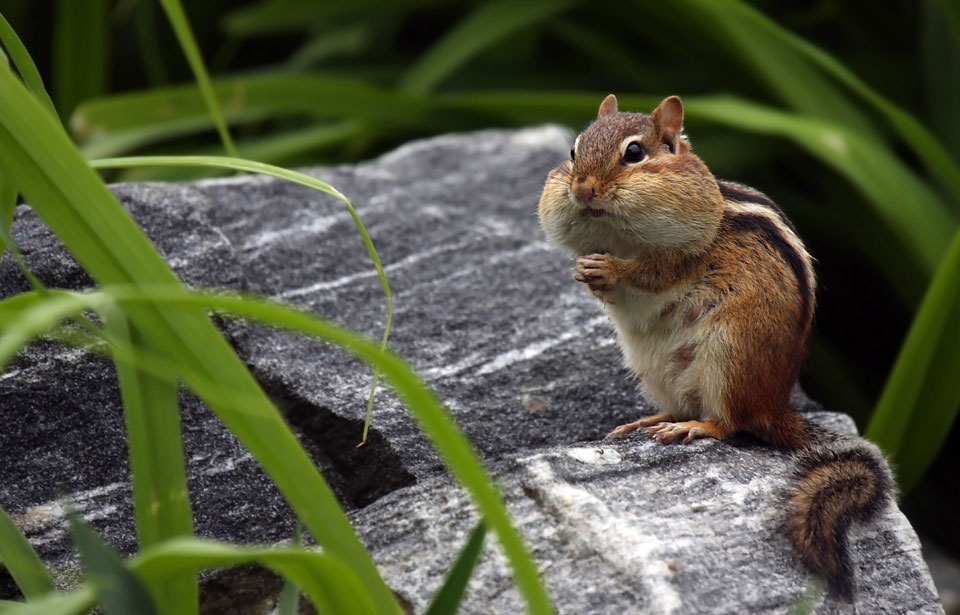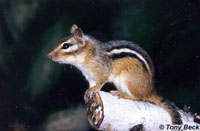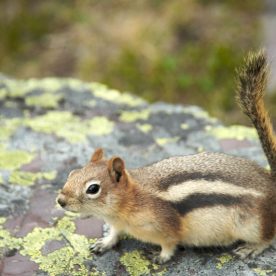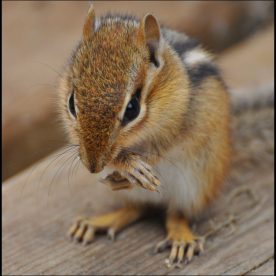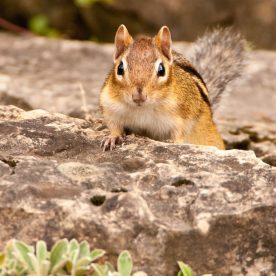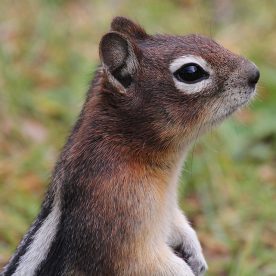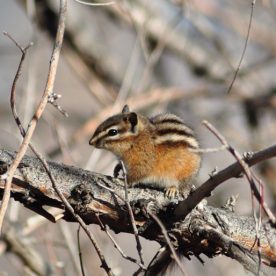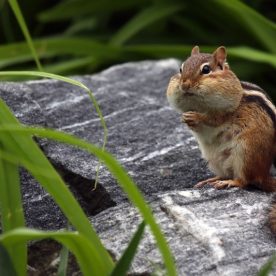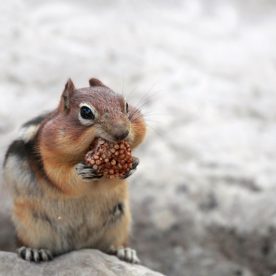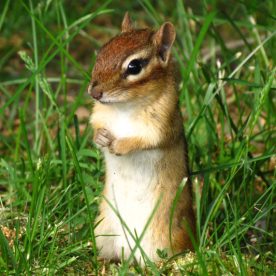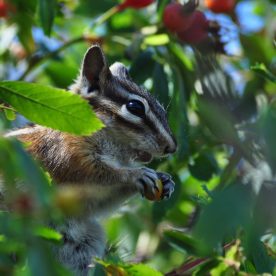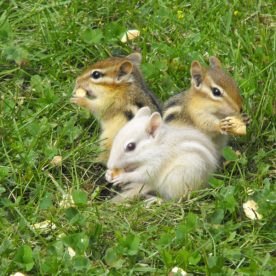Description
Chipmunks Tamias are easily recognized by the light and dark stripes on the back and head. They can be confused with some of the striped ground squirrels, but chipmunks are smaller, and have facial markings and five dark stripes on their backs, including a distinct, central line that extends forward onto the head. Ground squirrels do not have markings on the head.
The eastern chipmunk is a colourful and attractive rodent with bright russet on its hips, rump, and tail; black, grey, and white stripes on its back; brown, grey, and buff on its head; white underparts; and brown feet. The western chipmunk species are arrayed in shades of grey, brown, reddish, white, and buff and share a distinctive pattern of black, pale grey, and buff stripes, although in the Townsend’s chipmunk the colour contrasts of the stripes are masked by a warm brown overall wash. The red-tailed chipmunk is the most brightly coloured of the western species.
The eastern chipmunk is large (up to 125 g) with a relatively short tail (about one-third of the total length from its nose to the tip of its tail), whereas western chipmunks are smaller (about 55 g) with a relatively longer tail (nearly half the total length from its nose to the tip of its tail). The eastern chipmunk is between 20 and 30 cm long, and western species are 16 to 28 cm long.
Signs and sounds
Chipmunks are quite vocal. People walking in the woods do not always realize that they are hearing chipmunks, for some of the cries that chipmunks make are like bird chirps.
Biologists have not yet determined the meaning of all the chipmunk’s many calls. For example, when a chipmunk is startled, it runs quickly along the ground giving a rapid series of loud chips and squeaks. Perhaps this sudden burst of noise startles predators, helping the chipmunk to escape. Also, chipmunks frequently call with a high-pitched chip or chuck repeated over and over at intervals of one or two seconds. This scolding noise is often made by a chipmunk watching an intruder from a safe vantage point. Some scientists think that it may also be the mating call of the female chipmunk.
Habitat and Habits
All species of chipmunks in Canada live in forested areas. Most of them live in burrows and gather food on the ground, generally in areas where there are enough rocks, bushes, fallen logs, and piles of brush to shelter them from predators as they scamper about. Immature forests and the edges of forests near clearings, streams, ravines, and logging roads provide ample cover. Stands of tall, mature trees with no plants on the shady forest floor are unsuitable.
Chipmunks are fun to watch. They charm campers and hikers by their small size, their boldness in search of food, and their constant busyness. They are not hard to approach or photograph. An encounter with a chipmunk often provides a child with a captivating first experience of a wild mammal in its natural setting.
Surprisingly, in animals so quick to befriend curious children and delight all ages, chipmunks are solitary animals. Each chipmunk has its own burrow and ignores its fellows except when conflicts arise or during mating or when females care for their young.
Nevertheless, chipmunks are not territorial in the conventional sense. They use home ranges that overlap broadly (sometimes completely) and trespass repeatedly near each other’s burrows. Home ranges vary from 0.04 to 1.26 ha; usually those of adults are larger than those of juveniles and those of males larger than those of females. Boundaries change continually to include seasonally available food sources, but most animals probably maintain approximately the same home range from season to season.
Chipmunks spend most of their time in the part of their home range that includes their burrow, which is called their dominance area. Between these smaller areas there is no overlap. Within them the resident chipmunk is dominant and trespassers avoid interactions with the rightful owner, fleeing immediately if an encounter occurs. The boundaries of dominance areas are more stable than those of home ranges.
Most chipmunks construct tunnels and chambers in the ground. Entrances are well hidden under rocks or tangled bushes. Less typical are those western species that spend a fair amount of their time in trees and sometimes even nest in tree cavities.
Naturalists have dug up only a few burrows, all excavated by eastern chipmunks. Most of these consisted of a single entrance leading to an unbranched tunnel that sloped gradually down to a depth of 45 to 85 cm and ended in a rounded nest chamber, about 15 cm in diameter. In this chamber, the chipmunk had built a nest using insulating materials such as grasses, shredded leaves, or the fluffy seed heads of certain plants. Seeds and nuts stored beneath the nest provided a handy food supply for the coldest part of the winter. In a few cases, biologists unearthed complex burrow systems up to 4 m long with tunnels that branched and led to side tunnels and accessory chambers. In neither type of burrow was evidence of a latrine, or toilet area, found.
Chipmunks are known to be hibernators, even in the southern parts of their range. Near the end of July, they begin to collect and store large quantities of seeds. By October, each chipmunk has accumulated enough seeds to enable it to survive the winter.
With the onset of winter in November, chipmunks disappear below ground. At present, it is not known exactly what happens when chipmunks retire to their burrows for the winter. One view is that they immediately go into a torpid state. (In this state, the body temperature, rate of breathing, and rate of heartbeat drop to very low levels, reducing the amount of energy required to maintain the chipmunk.) Periods of torpor last from one to eight days, and perhaps longer. Between periods of torpor, chipmunks wake up and consume part of their food supply. They have occasionally been seen above ground on warm winter days. A second view is that chipmunks do not actually hibernate until their food supply has been exhausted.
With the first warm days of March, chipmunks begin to emerge, sometimes burrowing up through a metre of snow.
Unique characteristics
In Canada, in most years, chipmunks have only one breeding season and one litter, but in favourable years a small percentage of adult eastern chipmunks produces a second litter in the fall. In the southern United States, the production of two litters per year by both eastern and western chipmunks is not uncommon.
Range
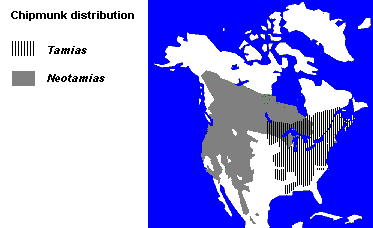 No species of chipmunk is found north of the treeline in Canada, in the prairie grasslands of North America, in the hot subtropical forests of Florida, or in areas with waterlogged soils. With those exceptions, chipmunks thrive throughout Canada and the United States. Some species of chipmunks even occur above the timber line on mountains and in the semidesert regions of the western United States. Their range extends south into Mexico along the mountains.
No species of chipmunk is found north of the treeline in Canada, in the prairie grasslands of North America, in the hot subtropical forests of Florida, or in areas with waterlogged soils. With those exceptions, chipmunks thrive throughout Canada and the United States. Some species of chipmunks even occur above the timber line on mountains and in the semidesert regions of the western United States. Their range extends south into Mexico along the mountains.
Twenty-one chipmunk species occur in North America, including one in eastern Canada and four in western Canada. All these species belong to the genus Tamias, which is divided into two main groups. The first subgenus, also called Tamias, contains the eastern chipmunk T. striatus, found in eastern Canada and the eastern United States. (It also contains the only species of chipmunk from outside North America, T. sibericus of China.) The other subgenus, Neotamias, contains 20 species, all of which are native to western North America. Four Neotamias species are found in western Canada. The least chipmunk T. minimus is the most common and has the largest range, followed by the yellow-pine chipmunk T. amoenus and the red-tailed chipmunk T. ruficaudus; the Townsend’s chipmunk T. townsendii is found in Canada only in the extreme southwestern corner of British Columbia.
Feeding
A chipmunk spends much of its day collecting and storing seeds, which are its most important source of food. Although most species of chipmunks usually forage on the ground, they all easily climb trees and shrubs to harvest nuts and fruit.
When preparing food for storage, the chipmunk holds fruit and seeds in its dexterous front paws, and with specialized incisors, or sharp cutting teeth, which are especially long and directed forward, it removes seeds from pods. Then it uses its tongue to shift the seeds backwards and stuff them between its teeth and the extensible skin in the cheek area, where they are held while the animal collects more food. The capacity of these cheek pouches increases with maturity. When the cheek pouches become full, the chipmunk deposits the seeds in its nest or buries them in shallow holes that it digs in the ground and then covers with earth, leaves, and other litter.
In spring, chipmunks diligently search the ground for any seeds that remain from the previous summer. As these are usually scarce, the small rodents eat young leaves and shoots until new fruit and seeds become available. Throughout the spring, summer, and autumn, the chipmunk’s diet is supplemented with insects, earthworms, flowers, berries, cherry and plum pits, mushrooms, and occasionally eggs or flesh of dead animals. Rare instances of chipmunks preying on birds or small mammals have been observed.
Breeding
Male chipmunks are the first to emerge in the spring, as soon as patches of bare ground begin to appear through the snow. The females emerge one or two weeks later. Soon after, mating takes place near the female’s burrow. Several males may compete for a female, and a male may mate with more than one female during one breeding season. In Canada, the main breeding season is from mid-April to mid-May.
The gestation, or pregnancy, period is about 30 days. When it is over, the female chipmunks rear their litters—usually four to six young—without any help from males. In Canada, in most years, chipmunks have only one breeding season and one litter, but in favourable years a small percentage of adult eastern chipmunks produces a second litter in the fall. In the southern United States, the production of two litters per year by both eastern and western chipmunks is not uncommon.
Young chipmunks are born naked and blind and weigh about 3 g at birth, with some variation by species.In the eastern chipmunk, hair does not become visible to the unaided eye until about 10 days of age, the ears are closed until around the 28th day, and the eyes open at 31 to 33 days of age.
When they are four to seven weeks old, the young chipmunks begin to leave the burrow to forage. At first they are unafraid, but after a few days above ground they are more wary and escape quickly if disturbed. The young grow rapidly during the late summer and reach adult size before the end of September. Most breed in their first spring, but some may wait until their second year.
Conservation
Chipmunk numbers usually do not vary much from year to year, but local declines and disappearances have been recorded. These declines have never been satisfactorily explained.
Chipmunks must practise constant vigilance to avoid their many predators, including hawks, weasels, coyotes, martens, foxes, and snakes. Occasionally they are hunted by owls, but such incidents are rare as chipmunks are only active by day. Despite these many enemies, there are not enough of these tiny rodents for any predator to depend on a steady diet of chipmunk. It makes more sense for a predator to specialize in mice, which are more abundant and more easily caught. In inhabited areas, chipmunks also fall prey to cats and dogs, and a fair number are killed by automobiles.
Chipmunks can be seriously wounded when they compete among themselves or with large animals, such as red squirrels, for food and space. In addition, some may die as a result of wounds received in fights during the breeding season. Males fight among themselves when competing for females, and females have been observed defending their nests and young against other chipmunks.
Disease and food shortage may also limit chipmunk populations but, once again, little is known about these factors. Seed crop failures are likely to have a significant detrimental effect on chipmunks, which depend on stored food to survive the winter. Disease epidemics have not been reported from chipmunks but are known to occur in populations of mice and other rodents. Parasites, such as botfly larvae, tapeworms, fleas, mites, and probably lice, can have a debilitating effect and, on rare occasions, even cause death.
Chipmunks are important in the dispersal of seeds because of their habit of storing the seeds beneath the layer of decaying vegetation on the forest floor. Any buried seeds that are not consumed stand a better chance of germinating than those remaining on the surface litter. In this way, chipmunks assist in the spread of shrubs, trees, and other plants.
If chipmunks are very abundant, they can prevent normal reforestation of some trees, especially pines, by eating their seeds. Occasionally chipmunks and other rodents are trapped to ensure adequate germination and growth of seedlings. Poisoning is not an acceptable means of control because of the harmful effects on other wildlife, including gamebirds and songbirds.
Much of the value of chipmunks lies in the pleasure they provide for campers, hikers, and anyone who enjoys the country. Our national and provincial parks and our summer cottages and trailers would be less interesting and less enjoyable without chipmunks dashing across forest trails or boldly helping themselves to food in campgrounds and picnic areas.
Resources
Online Resources
Printed Resouces
Forsyth, A. 1985. Mammals of the Canadian wild. Camden House Publishing, Camden East, Ontario.
Hall, E.R. 1981. Mammals of North America. John Wiley and Sons, New York.
Henisch, B., and H. Henisch. 1970. Chipmunk portrait. Carnation Press, State College, Pennsylvania.
MacClintock, D. 1970. Squirrels of North America. Van Nostrand Reinhold Co., New York.
Tunis, E. 1971. Chipmunks on the doorstep. Thomas Y. Crowell Co., New York.
Wishner, L. 1982. Eastern chipmunks. Secrets of their solitary lives. Smithsonian Institution Press, Washington, D.C.
Woods, S.E. 1980. The squirrels of Canada. National Museum of Natural Sciences, Ottawa.
© Her Majesty the Queen in Right of Canada, represented by the Minister of the Environment, 1969, 1973, 1985, 1990. All rights reserved.
Catalogue number CW69-4/13-1990E
ISBN 0-660-13464-0
Text: David Sheppard
Revision: B.T. Aniskowicz, 1989
Photo: Tony Beck



